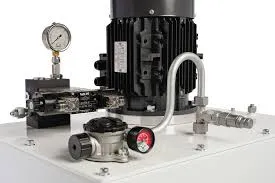Aug . 21, 2024 16:20 Back to list
Filling Techniques for Hydraulic Cylinder Products and Their Importance
Understanding the Importance of Filling Hydraulic Cylinders
Hydraulic cylinders are fundamental components of hydraulic systems, responsible for converting hydraulic energy into mechanical energy. These robust devices play a crucial role in various applications, from heavy machinery in construction and mining to industrial automation and automotive systems. One of the critical aspects of hydraulic cylinder functionality is the proper filling of the hydraulic fluid, which ensures optimal performance and longevity.
What is Hydraulic Cylinder Filling?
Filling a hydraulic cylinder involves introducing hydraulic fluid—commonly oil—into the cylinder to ensure it operates efficiently. This fluid acts as a medium for transmitting force and motion, allowing the cylinder to extend and retract as needed. The filling process must be conducted carefully to avoid contamination, air inclusion, and ensure the required pressure is achieved for the hydraulic system to function correctly.
The Filling Process
The hydraulic cylinder filling process consists of several steps
1. Preparation Before filling, it is critical to inspect the hydraulic cylinder for any signs of damage or wear, which could lead to leaks or malfunction. Cleanliness is paramount; contaminants can severely affect the fluid's performance and the cylinder's endurance.
2. Choosing the Right Fluid Selecting the appropriate hydraulic fluid is essential. The fluid must be compatible with the materials of the hydraulic cylinder and must have the right viscosity for the operating temperatures expected in the application.
3. Evacuating Air After ensuring the cylinder is clean and ready for filling, air must be evacuated from the cylinder. Air bubbles can compromise the hydraulic system's efficiency, leading to erratic movement or reduced force output. Various techniques, such as bleeding valves, may be employed to remove trapped air.
4. Filling the Cylinder The filling can be executed using manual or automated systems. Care must be taken to fill the cylinder to the appropriate level, as overfilling can cause hydraulic fluid to overflow and underfilling can lead to air in the system.
filling hydraulic cylinder product

5. Testing and Monitoring Post-filling, the cylinder should be tested under operating conditions to ensure everything functions correctly. Monitoring the hydraulic pressure and fluid levels during initial use can help detect any potential issues early.
Importance of Proper Filling
Proper filling of hydraulic cylinders is crucial for several reasons
- Efficiency Well-filled hydraulic cylinders operate smoothly and efficiently, reducing energy consumption and enhancing performance.
- Longevity Contaminants and air can lead to wear and tear of internal components. Proper filling helps maintain the integrity of seals and pistons, prolonging the life of the cylinder.
- Safety Hydraulic systems operate under high pressure, and any malfunction can lead to catastrophic failures. A well-filled cylinder reduces the likelihood of hydraulic failure, ensuring safety for operators and equipment.
- Cost-Effectiveness Preventative maintenance, including proper filling practices, can result in significant cost savings. By reducing downtime and minimizing the need for repairs, organizations can enhance productivity and profitability.
Conclusion
In summary, filling hydraulic cylinders is a critical process that demands attention to detail and proper techniques. Understanding the importance of this aspect not only contributes to the efficient operation of hydraulic systems but also promotes safety and longevity of the machinery. As industries continue to evolve, maintaining best practices in hydraulic fluid management will remain vital for achieving optimal performance in various applications. By investing time and effort into the filling process, operators can ensure the reliability and efficiency of their hydraulic systems for years to come.
-
Fork Lift Power Units - Hebei Shenghan | Efficiency, Reliability
NewsJul.13,2025
-
1.5-Ton Turbocharged Cylinder-Hebei Shenghan|Hydraulic Solution,Energy Efficiency
NewsJul.13,2025
-
Auto Hoist Power Units-Hebei Shenghan|Efficiency&Industrial Lifting
NewsJul.13,2025
-
Double Acting Power Units-Hebei Shenghan|Hydraulic Solutions,Industrial Efficiency
NewsJul.13,2025
-
1.5 Ton Lifting Cylinder 70/82-40-290-535 - High-Performance Hydraulic Solution | Hebei Shenghan
NewsJul.13,2025
-
Fork Lift Power Units - Hebei Shenghan | Efficiency&Reliability
NewsJul.13,2025
